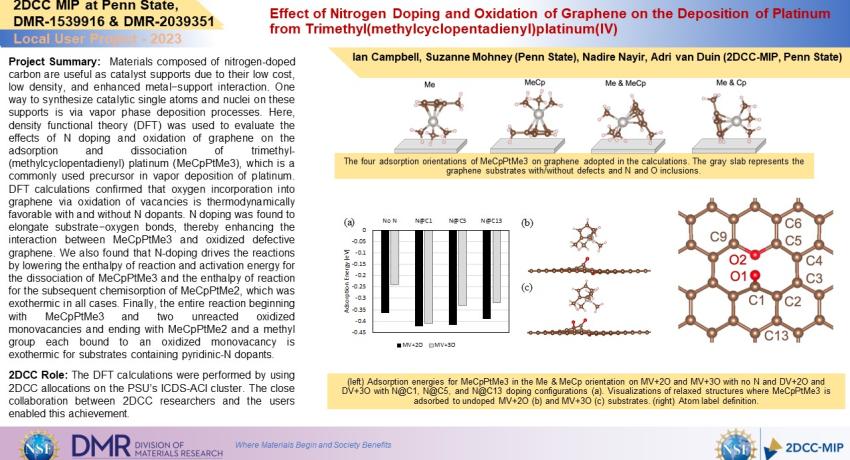Project Summary: Materials composed of nitrogen-doped carbon are useful as catalyst supports due to their low cost, low density, and enhanced metal−support interaction. One way to synthesize catalytic single atoms and nuclei on these supports is via vapor phase deposition processes. Here, density functional theory (DFT) was used to evaluate the effects of N doping and oxidation of graphene on the adsorption and dissociation of trimethyl- (methylcyclopentadienyl) platinum (MeCpPtMe3), which is a commonly used precursor in vapor deposition of platinum. DFT calculations confirmed that oxygen incorporation into graphene via oxidation of vacancies is thermodynamically favorable with and without N dopants. N doping was found to elongate substrate−oxygen bonds, thereby enhancing the interaction between MeCpPtMe3 and oxidized defective graphene. We also found that N-doping drives the reactions by lowering the enthalpy of reaction and activation energy for the dissociation of MeCpPtMe3 and the enthalpy of reaction for the subsequent chemisorption of MeCpPtMe2, which was exothermic in all cases. Finally, the entire reaction beginning with MeCpPtMe3 and two unreacted oxidized monovacancies and ending with MeCpPtMe2 and a methyl group each bound to an oxidized monovacancy is exothermic for substrates containing pyridinic-N dopants.
2DCC Role: The DFT calculations were performed by using 2DCC allocations on the PSU’s ICDS-ACI cluster. The close collaboration between 2DCC researchers and the users enabled this achievement.
What Has Been Achieved: In this work, we have used Density Functional Theory calculations to study the effect of nitrogen doping on Pt-deposition on oxygen decorated graphene defects. We found that N-doping leads to more favorable interactions with the Pt-metalorganic complexes, since the N-doping weakens the C-O bonding, making the O-atoms better landing sites for the Pt.
Importance of the Achievement: Defected graphene is an important catalyst support – due to its high surface area, high mechanical stability and low chemical reactivity. This study provides a thermodynamic and kinetic analysis of the deposition of Pt-metal clusters on the graphene support, which provides guidance for synthesis efforts.
Unique Feature(s) of the MIP that Enabled this Achievement: 2DCC-MIP’s allocations on the PSU’s Institute for Computational and Data Sciences - Advanced Cyber Infrastructure (ICDS-ACI) cluster enable the DFT calculations associated with this work.
Publication: Campbell, I.E., Nayir, N., van Duin, A.C.T. and Mohney, S. (2022) N-Doping and Oxidation Dependence of Graphene Surface Reactivity During Vapor Deposition of Platinum Journal of Physical Chemistry 126, 16357-16368.
Acknowledgment: Funding was provided by the National Science Foundation through the Pennsylvania State University MRSEC Program (DMR-1420620) and the Pennsylvania State University 2D Crystal Consortium−Materials Innovation Platform (2DCC-MIP) under NSF cooperative agreements DMR-1539916 and DMR-2039351.
